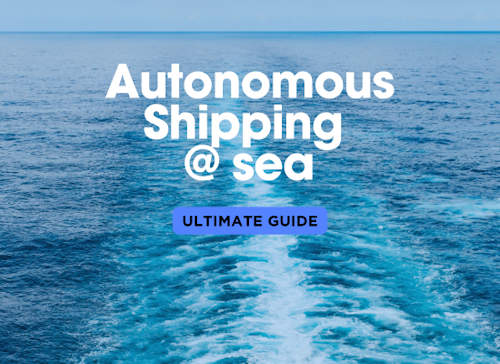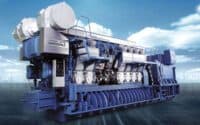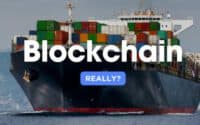Autonomous Shipping @ Sea: Ultimate Guide for Fleet Owners

As the maritime industry continues to evolve, autonomous shipping is emerging as one of the most transformative advancements on the horizon. While the concept of ships navigating the seas with minimal human intervention may have once seemed far-fetched, technological innovations are rapidly making it a reality. For fleet owners, understanding the implications of autonomous shipping is crucial, not only for staying competitive but also for making informed decisions about the future of their operations. We will explore the current state of autonomous shipping technology, its potential benefits, and the challenges it presents, including the sensitive issue of its impact on maritime employment. By carefully weighing the pros and cons, fleet owners can navigate this new landscape with foresight and responsibility.
Regulatory Landscape / Benefits / Crew Impact / Cost-Benefit Analysis / Insurance / Outlook
| ShipUniverse: Current State of Autonomous Shipping Technology | ||
|---|---|---|
| Technology Type | Description | Stage of Development |
| Autonomous Navigation Systems | Systems that enable ships to navigate autonomously using a combination of GPS, radar, LIDAR, and advanced algorithms for real-time decision-making and route optimization. |
|
| Remote Monitoring and Control Systems | Technology allowing human operators to oversee and control ship operations remotely, often from onshore control centers, ensuring safety and efficiency. |
|
| Collision Avoidance Systems | Advanced systems utilizing sensors, AI, and machine learning to detect and navigate around obstacles, significantly reducing the risk of collisions. |
|
| Autonomous Engine and Propulsion Systems | Automation of engine and propulsion systems to optimize performance, efficiency, and fuel consumption without direct human intervention. |
|
| AI-Based Decision Support Systems | Artificial intelligence platforms that analyze data from multiple sources to assist in real-time decision-making and optimize operations. |
|
| Digital Twin Technology | Virtual replicas of physical ships that simulate operations in real-time, enabling predictive maintenance, operational planning, and scenario testing. |
|
| Automated Docking Systems | Systems that allow ships to dock automatically using sensors, cameras, and AI to guide the vessel safely into position without human intervention. |
|
| Cybersecurity Systems for Autonomous Ships | Enhanced cybersecurity measures designed to protect autonomous ships from hacking and cyber threats, ensuring safe and secure operations. |
|
Regulatory Landscape
Navigating the regulatory landscape is a critical aspect of adopting autonomous shipping technologies. The current regulatory environment is still evolving, with various international and regional bodies working to establish frameworks that ensure the safe and efficient operation of autonomous ships. Here's a breakdown of the current state and potential future developments:
Current Regulatory Environment:
- International Maritime Organization (IMO):
- The IMO is leading efforts to develop a comprehensive regulatory framework for autonomous ships, known as Maritime Autonomous Surface Ships (MASS).
- Currently, the IMO is in the process of evaluating existing conventions (e.g., SOLAS, COLREGs) to identify necessary amendments to accommodate autonomous technologies.
- The IMO has launched a scoping exercise to assess the need for new regulations or adjustments to existing ones to ensure safety and compliance.
- Regional Regulations:
- European Union:
- The EU is actively involved in the development of autonomous shipping regulations, focusing on safety, environmental impact, and operational standards.
- Initiatives like the EU’s Horizon 2020 project have funded research and pilot projects to explore the practical implementation of autonomous ships.
- United States:
- The U.S. Coast Guard is working on guidelines for autonomous vessel operations within U.S. waters, emphasizing safety, cybersecurity, and environmental protection.
- Current regulations are being reviewed to accommodate the unique needs of autonomous shipping, particularly regarding crew requirements and navigation rules.
- Asia-Pacific:
- Countries like Japan, South Korea, and Singapore are at the forefront of developing regulations for autonomous ships, with several pilot programs underway.
- Regional bodies are collaborating to ensure harmonized standards that facilitate international trade.
- European Union:
Potential Future Regulations:
- Harmonization of International Standards:
- Future regulations are likely to focus on harmonizing standards across regions to ensure that autonomous ships can operate globally without facing conflicting rules.
- This may involve the creation of a unified set of guidelines by the IMO that all member states adopt, covering aspects like navigation, communication, and safety.
- Liability and Insurance:
- New regulations will likely address the issue of liability in the event of accidents or incidents involving autonomous ships.
- Fleet owners may need to adapt to changes in insurance requirements, with policies that specifically cover the unique risks associated with autonomous operations.
- Cybersecurity and Data Protection:
- As autonomous ships rely heavily on digital systems, future regulations are expected to include stringent cybersecurity standards to protect against hacking and data breaches.
- Compliance with data protection laws will also be crucial, especially for international operations that involve the transfer of sensitive information across borders.
- Crew and Training Requirements:
- Although autonomous ships reduce the need for traditional crew roles, future regulations may still require some level of human oversight, particularly in remote monitoring and emergency response.
- Training programs for crew members will need to evolve to include skills related to operating and managing autonomous systems.
- Environmental and Safety Regulations:
- Autonomous ships will be subject to the same environmental regulations as conventional vessels, with potential additional requirements for monitoring and reporting emissions and other environmental impacts.
- Safety regulations may be updated to include protocols for emergency situations specific to autonomous vessels, such as system failures or loss of communication.
Potential Benefits
As the maritime industry embraces the future of autonomous shipping, fleet owners stand to gain significantly from the adoption of these cutting-edge technologies. Autonomous ships promise a host of benefits that can transform operations, from reducing costs and enhancing safety to improving efficiency and environmental sustainability. However, understanding these advantages in practical terms is crucial for making informed decisions about integrating autonomous technologies into your fleet. The table below provides an in-depth look at the key benefits of autonomous shipping, supported by real-world case studies that showcase how early adopters are already reaping the rewards of this innovation.
| ShipUniverse: Benefits of Autonomous Shipping | ||
|---|---|---|
| Benefit | Description | Impact on Fleet Owners |
| Reduced Operational Costs | Autonomous ships reduce the need for large onboard crews, lowering labor costs. They also optimize fuel consumption and minimize downtime through predictive maintenance. |
|
| Improved Safety | Autonomous systems eliminate human error, which is a leading cause of maritime accidents. Advanced sensors and AI-driven decision-making enhance situational awareness and collision avoidance. |
|
| Enhanced Efficiency | Autonomous ships can operate continuously without the need for rest breaks, leading to faster journey times. They can also optimize routes in real-time based on weather and sea conditions. |
|
| Environmental Benefits | Autonomous ships are typically more fuel-efficient and can be designed to minimize environmental impact. They also support better compliance with environmental regulations through automated monitoring. |
|
| Scalability and Adaptability | Autonomous shipping technologies can be scaled across fleets and adapted to various ship types, from cargo vessels to offshore supply ships, providing flexibility for fleet owners. |
|
Impact on Crew and Employment
The rise of autonomous shipping presents a significant shift in the maritime industry, with far-reaching implications for crew roles and employment opportunities. As vessels become increasingly automated, the traditional roles of seafarers are evolving, requiring new skills and competencies. While autonomous ships promise increased efficiency and safety, they also raise concerns about job displacement and the need for retraining programs. Here's a closer look at how autonomous shipping is likely to impact crew roles and employment, along with strategies to help current maritime workers transition into new roles.
Evolving Crew Roles and Job Opportunities
- Reduction in Onboard Crew:
- Autonomous ships significantly reduce the need for large onboard crews, particularly for routine operations like navigation and engine management.
- Roles such as helmsman, navigator, and traditional engineers may see a decline as their tasks are increasingly automated.
- Emergence of New Roles:
- New roles are emerging, particularly in remote operations centers where human operators monitor and control autonomous ships.
- Positions such as Remote Vessel Operators, Autonomous Systems Technicians, and Cybersecurity Specialists are becoming increasingly important.
- Focus on Technical and IT Skills:
- As automation and digital systems take over traditional tasks, there is a growing need for crew members with strong technical and IT skills.
- Roles that involve managing and maintaining autonomous systems, data analysis, and cybersecurity will be in high demand.
Retraining Programs and Transition Strategies
- Development of Retraining Programs:
- Maritime organizations and training institutions are developing retraining programs to help current employees adapt to the new technological landscape.
- These programs focus on upskilling crew members in areas such as digital navigation, remote vessel management, and system diagnostics.
- Partnerships with Educational Institutions:
- Partnerships between shipping companies and educational institutions are key to providing ongoing training and certification in emerging technologies.
- Programs that combine theoretical knowledge with practical, hands-on experience will be essential for effective retraining.
- Transitioning to Shore-Based Roles:
- Many traditional seafaring roles can transition to shore-based positions, such as in remote operations centers or fleet management offices.
- Encouraging crew members to consider these transitions can help mitigate the impact of job displacement.
- Continuous Professional Development (CPD):
- Continuous professional development programs are crucial for ensuring that maritime workers stay current with the latest technological advancements.
- CPD programs can offer specialized training modules focused on emerging technologies, ensuring that crew members remain valuable assets to their employers.
| ShipUniverse: Impact on Crew Roles and Employment | ||
|---|---|---|
| Crew Role | Impact | Required Skills for Transition |
| Helmsman/Navigator | Role is likely to diminish as autonomous navigation systems take over routine navigation tasks. Fewer navigators needed on board; some may transition to remote monitoring roles. |
|
| Marine Engineer | Traditional engineering roles may decline as autonomous systems handle engine management and diagnostics. Engineers will need to adapt to overseeing automated systems remotely. |
|
| Deck Officer | Fewer deck officers will be required on autonomous ships, with some transitioning to roles in remote operations centers or safety monitoring positions. |
|
| Remote Vessel Operator | A new role that is expected to grow, where operators manage and monitor autonomous ships from onshore control centers. |
|
| Cybersecurity Specialist | This role will become increasingly important as autonomous ships rely on complex digital systems that are vulnerable to cyber threats. |
|
| Autonomous Systems Technician | Technicians who specialize in maintaining and troubleshooting the autonomous systems on board and remotely will be in high demand. |
|
Cost-Benefit Analysis for Fleet Owners
Adopting autonomous shipping technologies requires a substantial financial commitment, but the potential long-term savings and efficiencies can make it a worthwhile investment for fleet owners. To make an informed decision, it’s essential to break down the various costs involved and weigh them against the benefits.
Costs Associated with Adopting Autonomous Shipping Technologies
- Initial Investment:
- Autonomous Systems and Hardware:
- Installation of autonomous navigation systems, sensors, and remote monitoring equipment.
- Upgrading existing vessels or purchasing new autonomous-ready ships.
- Software and Integration:
- Costs associated with the deployment of advanced software for navigation, monitoring, and decision-making.
- Integration with existing fleet management systems.
- Autonomous Systems and Hardware:
- Maintenance and Upkeep:
- System Maintenance:
- Regular maintenance of autonomous systems to ensure reliability and efficiency.
- Costs associated with software updates, cybersecurity measures, and hardware repairs.
- Predictive Maintenance:
- Investment in predictive maintenance technologies that monitor the health of ship components in real-time, reducing the risk of unexpected failures.
- System Maintenance:
- Training and Retraining:
- Crew Training Programs:
- Training programs for crew members to manage and oversee autonomous systems.
- Retraining for new roles, such as remote vessel operators and systems technicians.
- Continuous Professional Development:
- Ongoing education and certification to keep pace with technological advancements.
- Crew Training Programs:
- Insurance and Liability Adjustments:
- Policy Updates:
- Modifications to insurance policies to cover autonomous operations, including new risk factors.
- Liability Considerations:
- Potential changes in liability distribution in the event of an incident involving an autonomous vessel.
- Policy Updates:
Potential Long-Term Savings and Efficiencies
- Reduced Operational Costs:
- Lower Labor Costs:
- Significant reduction in crew sizes, leading to lower salaries, benefits, and living expenses on board.
- Fuel Efficiency:
- Optimized routes and speeds, resulting in reduced fuel consumption.
- Decreased Maintenance Costs:
- Fewer unexpected breakdowns and extended equipment life through predictive maintenance.
- Lower Labor Costs:
- Increased Operational Efficiency:
- 24/7 Operations:
- Autonomous ships can operate continuously without the need for rest, reducing transit times.
- Higher Cargo Throughput:
- Enhanced scheduling and routing lead to increased cargo handling capacity.
- Improved Safety:
- Reduced risk of accidents due to human error, potentially lowering insurance premiums.
- 24/7 Operations:
- Scalability and Future-Proofing:
- Scalability:
- Technologies can be scaled across fleets, providing consistency and efficiency.
- Future-Proofing:
- Early adoption of autonomous technologies positions fleet owners to adapt more easily to future regulations and industry trends.
- Scalability:
| ShipUniverse: Cost-Benefit Analysis of Adopting Autonomous Shipping | ||
|---|---|---|
| Cost Category | Details | Potential Long-Term Savings |
| Initial Investment |
|
|
| Maintenance and Upkeep |
|
|
| Training and Retraining |
|
|
| Insurance and Liability Adjustments |
|
|
Insurance and Liability Considerations
As autonomous shipping technologies advance, the insurance landscape for fleet owners is poised to change significantly. Traditional insurance policies may not fully cover the unique risks associated with autonomous vessels, necessitating updates and new types of coverage. Additionally, the question of liability—particularly who is responsible in the event of an incident—becomes more complex with autonomous operations.
Adapting Insurance Policies for Autonomous Vessels
- Coverage for Autonomous Operations:
- Insurers may need to create specialized policies that account for the unique risks associated with autonomous ships, including system failures, cybersecurity breaches, and reduced human oversight.
- Premiums may be adjusted based on the level of autonomy, the technology used, and the track record of the autonomous systems.
- Risk Assessment and Underwriting:
- Insurance companies will likely develop new models for assessing the risks of autonomous operations, factoring in the reliability of technology, the experience of remote operators, and the vessel’s operational history.
- Fleet owners may benefit from lower premiums if their autonomous systems demonstrate high safety standards and reliability.
Liability Issues in Autonomous Shipping
- Determining Responsibility:
- With autonomous vessels, the question of liability in the event of an incident is more complex. Liability may shift from the ship’s crew to the technology providers, remote operators, or even the fleet owner.
- In cases where multiple parties are involved in the operation and management of the vessel, liability could be distributed among various stakeholders, depending on the nature of the incident.
- Legal Frameworks and Precedents:
- As autonomous shipping becomes more common, legal frameworks will need to evolve to address liability issues. This may involve new regulations or amendments to existing maritime laws.
- Fleet owners should stay informed about legal developments and work with legal experts to ensure they are adequately protected.
- Impact on Contracts and Agreements:
- Contracts with technology providers, operators, and other stakeholders will need to be clear about liability responsibilities in the event of an incident.
- Ensuring that all parties have appropriate insurance coverage and understanding their liability in different scenarios will be critical for managing risks.
Looking into the Future: The Next Frontier of Autonomous Shipping
As we stand on the brink of a new era in maritime shipping, the future of autonomous vessels is both exciting and uncertain. While significant progress has been made in developing and testing autonomous technologies, the full realization of autonomous shipping will likely unfold over the next few decades. Here’s a glimpse into what the future might hold for fleet owners, the industry, and global trade.
Advanced Integration of AI and Machine Learning
- Predictive and Adaptive Systems:
- Future autonomous ships will likely feature advanced AI systems capable of predictive and adaptive decision-making, allowing vessels to respond to real-time conditions like weather, traffic, and potential hazards more effectively.
- Machine learning algorithms will continuously improve the ship’s operational efficiency by analyzing vast amounts of data collected during voyages, leading to more optimized routes, fuel savings, and better maintenance schedules.
- Full Autonomy and Beyond:
- The industry might move from current semi-autonomous systems to fully autonomous vessels that can operate with little to no human intervention, even in complex maritime environments.
- This transition will depend on advancements in AI, regulatory approval, and the establishment of global standards for autonomous operations.
Global Standardization and Regulatory Frameworks
- International Collaboration:
- As autonomous ships become more prevalent, there will be a push for global standardization of regulations to ensure that vessels can operate seamlessly across international waters.
- Organizations like the International Maritime Organization (IMO) will play a critical role in developing these standards, focusing on safety, environmental impact, and liability issues.
- Regulatory Challenges:
- While progress is being made, regulatory challenges remain a significant barrier to the widespread adoption of autonomous shipping. Future regulations will need to address complex issues like cross-border operations, cyber threats, and the ethical implications of autonomous decision-making.
Economic and Environmental Impact
- Cost Reductions and Efficiency Gains:
- As technology matures, the costs associated with autonomous shipping are expected to decrease, making it more accessible to a broader range of fleet owners. This will lead to a more competitive and efficient maritime industry.
- Autonomous ships will contribute to significant reductions in fuel consumption and emissions, supporting global efforts to combat climate change.
- Shifts in Global Trade Patterns:
- Autonomous shipping could lead to shifts in global trade patterns, with new routes and hubs emerging based on the capabilities of autonomous vessels.
- The reduced need for crew and the ability to operate continuously without rest could lead to shorter transit times and more direct shipping routes.
Impact on Maritime Employment
- New Job Opportunities:
- While some traditional maritime jobs may decline, new opportunities will arise in fields like remote vessel operation, autonomous systems maintenance, and cybersecurity.
- The industry will need to invest in training and education to equip the next generation of maritime workers with the skills required for these new roles.
- Transition Strategies:
- Strategies to help current maritime workers transition into new roles will be crucial to ensuring a smooth shift to autonomous shipping. Retraining programs and continuous professional development will play a key role in this transition.
The Role of Collaboration and Innovation
- Partnerships and Ecosystems:
- The future of autonomous shipping will likely be shaped by collaborations between technology providers, shipbuilders, fleet owners, and regulatory bodies. These partnerships will drive innovation and ensure that the benefits of autonomy are fully realized.
- Ongoing Research and Development:
- Continuous research and development will be necessary to address the remaining technical and regulatory challenges. The industry will need to remain flexible and open to new ideas as autonomous technologies evolve.
The future of autonomous shipping holds immense potential for revolutionizing the maritime industry. While challenges remain, the progress made so far indicates that autonomous vessels will become a staple of global trade in the coming decades. Fleet owners who prepare now, by investing in technology, training, and partnerships, will be well-positioned to lead the way in this new era of maritime shipping. As we look forward, the focus must remain on balancing innovation with safety, efficiency, and the broader impact on society.

Do you have a Maritime Product or Service that may be of interest to Shipowners? Tell us about it here!
Do you have feedback or insights? Please reach out to editor @ shipuniverse.com



